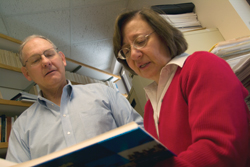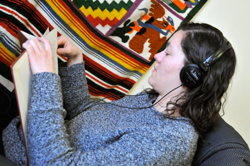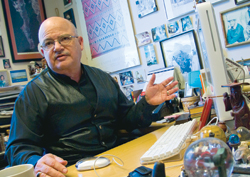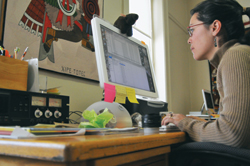
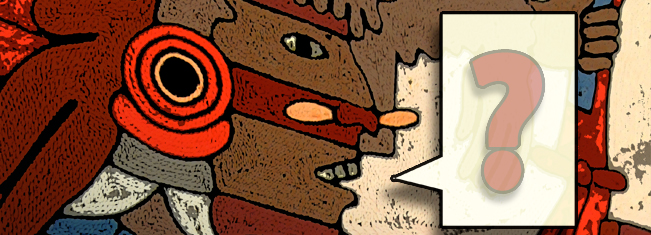
On the Brink
Around the globe, languages are dying out. But the U’s Center for American Indian Languages is working to preserve some of the most endangered and complex native tongues in the Americas.
by Vanessa Chang
No matter how you approach it, the future of the world’s many languages is bleak. The best-case scenario foresees that by the end of the 21st century, half of the 7,000 languages currently spoken will disappear. Another prediction puts the loss at 70 percent, while some linguistic experts don’t see a 95 percent loss as farfetched. And given the realities of cultural, economic, and political priorities around the globe, it’s certain that huge numbers of languages are destined to become extinct.
With such sobering statistics, the thought of simply giving in to the inevitable tide is tempting. But at Fort Douglas, on the U of U campus, a handful of scholars are refusing to accept defeat. In an unassuming building across from the parade ground, a monumental effort to save at least a few of the endangered languages is quietly under way. There, a Brazilian student works on a computer in preparation for field work with an Amazonian group, setting up schooling materials for children. At the top of a creaky set of stairs, graduate students from the Linguistics Department are listening to thousands of recorded interviews conducted with Mocho speakers in Central America in order to preserve the sounds, syntax, and stories of the endangered language and its speakers in a digital database. Downstairs, in the light-filled Wick Miller Collection Library, which holds texts on Native American studies and linguistics, U of U Professor of Linguistics Lyle Campbell is waiting for a fire engine siren to su bside. “It’s like doing field work,” he says of the Salt Lake City traffic noise. Here, he must deal with the cacophony of cars, while on field excursions he encounters “donkeys and screaming kids,” he says, reliving memories of the countless weeks he has spent working in indigenous communities in Central and South America.
Lyle Campbell and Marianna DiPaolo
For the past three years, Campbell has served as director of the Center for American Indian Languages (CAIL). The center’s primary goals are to document and revitalize endangered languages in North, Central, and South America. “There’s a lot of work to be done,” Campbell says of the center, which is unique in its scope and mission.
Keeping in mind the daunting statistics and the giant task of the small but dedicated team of CAIL scholars and graduate students, the question arises: why bother, if the future of languages looks so grim?
Robert D. Newman, dean of the College of Humanities, offers a ready
answer, noting the immediacy of CAIL’s impact. “The center is doing
something cutting edge,” he explains. “The humanities are about pushing
the frontiers of knowledge and also about not losing the memory of the
past and wisdom gained from it. As a State university, we have a special
commitment to the local community.” The presence of Campbell (widely
regarded as one of the best scholars in the field of Native American
languages), the annual Conference on Endangered Languages and Cultures
of Native America (CELCNA) at the U, and a partnership with the Smithsonian
Institution have given momentum to an already vibrant department, which
also includes Professor Mauricio Mixco, another specialist in Native
American linguistics. (See “Keeper
of the Word” in the Spring 2001 issue of Continuum.)
Nancy Garcia, a graduate assistant, works on curriculum development for the Shoshone project.
Scholars like Mixco and Marianna DiPaolo, an associate professor of linguistics, see the need for such efforts not only for academic purposes, but also for cultural ones. The two are focused on a project aimed at preserving the recollections and language of native Shoshone speakers of the Great Basin area using hours of recorded oral histories, many of them obtained by the renowned scholar Wick Miller, an anthropological linguist who specialized in the study of indigenous languages of the western United States and northwest Mexico, and whose name graces the CAIL library. “Most native Shoshone speakers are in their 60s and 70s,” says Mixco. “When they die, the language, the knowledge, and the identity of being Shoshone dies with them.” He notes the pivotal contributions made by Sacagawea to the 18th-century Lewis and Clark expedition, which allowed the explorers to survive a harsh, unknown environment. DiPaolo says, “Without her knowledge [of the Shoshone] language and way of life, their discoveri es would never have been possible.”
“The wisdom of humanity is coded in language,” explains Campbell. “Much of [contemporary] pharmaceutical research takes place in areas where languages are endangered-the languages that hold the key to the cultural knowledge on how to use plants and wildlife. Once the languages die, the knowledge dies with them.”
The Shoshone project is a local example of CAIL’s community impact. Mixco, DiPaolo, and a handful of graduate students work not only to document the language with digitized recordings, creating dictionaries and grammar books, but also to make these materials accessible to the Shoshone community at large. “We only go where communities ask for help in revitalizing a language,” DiPaolo explains. Scholars are now careful to be sensitive to the needs and desires of groups that have previously suffered years of cultural imposition. And, observes DiPaolo, “These communities that have been labeled as ’primitive’ actually have extremely complicated linguistic systems. Nothing primitive there.”
Campbell’s work in Central and South America follows the same pattern. After a lengthy history of being oppressed and subjected to prejudicial state policies, many groups are looking to reinvigorate cultural pride, which inevitably includes teaching languages to younger generations. But in many instances, CAIL’s efforts are running against the clock. “Some of these language groups have as few as 20 [remaining] speakers,” Campbell says. “In the event of a natural disaster, they could die or get displaced, and the languages will be gone.”
All three professors, beset with an obvious sense of urgency, are dedicated not only to academic inquiry but also to humanitarian need. To these linguists, cultural diversity is as vital to the world as biological diversity is to a botanist-and when it comes to preserving languages, and the deep knowledge inherent in them, the two concerns often intersect.
Katherine Matsumoto-Gray, a graduate assistant, checks Shoshone transcriptions for accuracy—a time-consuming
and complex task.
Campbell notes that, regarding diversity, both scientific and humanitarian passions run high. “Language is identity,” he says. “When you lose it, you statistically put yourself in line with social problems like alcoholism.” To scholars such as Campbell, documenting endangered languages and revitalizing them in local communities is one way to stem the effects of cultural genocide promoted through years of certain governments’ social and political policies. “It’s our responsibility as linguists to do what we can,” he continues. “Linguistics is a study of human cognition, what makes the mind tick, click, and work. When we lose, say, 50 percent of languages, we’re losing 50 percent of human cognitive ability. It’s a tragedy.”
Funding from the National Science Foundation and the Smithsonian Institution jumpstarted the current projects, but as requests and interest grow, additional funding will be needed to help the program meet demand. Much of the work also falls to a small but growing pool of graduate students pursuing degrees in linguistics or Certificates in Revitalization of Endangered Languages and Cultures (CRELCs). Obviously, the more qualified scholars there are focusing on these projects, the more successful CAIL’s programs will be.
Still, the goal isn’t to completely reverse the grim statistics of
ongoing language loss, but rather to stem the tide’s velocity to a level
where the knowledge amassed by respective cultures—whether it pertains
to medicine, climate, or customs—can be recorded and passed down to
future generations and enjoyed by the world at large.
For more information about the Center for American Indian Languages,
visit www.cail.utah.edu.
Gone Forever: A Partial Listing of Extinct Languages of the Americas
|
North & Central America
Adai (U.S.: Louisiana, Texas)
Aranama-Tamique (U.S.: Texas)
Atakapa (U.S.: Louisiana, Texas)
Beothuk (Canada: Newfoundland)
Calusa (U.S.: Florida)
Cayuse (U.S.: Oregon, Washington)
Chiapanec (Mexico)
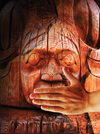
|
Chitimacha (U.S.: Louisiana)
Cholti (Guatemala)
Cotoname (northeast Mexico; U.S.: Texas)
Lenca (El Salvador, Honduras)
Mangue (Nicaragua)
Maratino (northeastern Mexico)
Naolan (Mexico: Tamaulipas)
Nicarao (Nicaragua)
Quinigua (northeast Mexico)
Solano (northeast Mexico; U.S.: Texas)
Yana (U.S.: California) |
South America
Baenan (Brazil)
Culle (Peru)
Cunza (Chile, Bolivia, Argentina)
Gamela (Brazil: Maranhão)
Gorgotoqui (Bolivia)
Huamoé (Brazil: Pernambuco)
Kukurá (Brazil: Mato Grosso)
Natú (Brazil: Pernambuco)
Ona (Tierra del Fuego)
Tuxá (Brazil: Bahia, Pernambuco)
Xokó (Brazil: Alagoas, Pernambuco)
Xukurú (Brazil: Pernambuco, Paraíba)
Yunga (Peru)
Yurumanguí (Colombia) |
—Vanessa Chang is a freelance writer living in Salt Lake City.
Return to Spring 2008 table of contents | Back to top |



